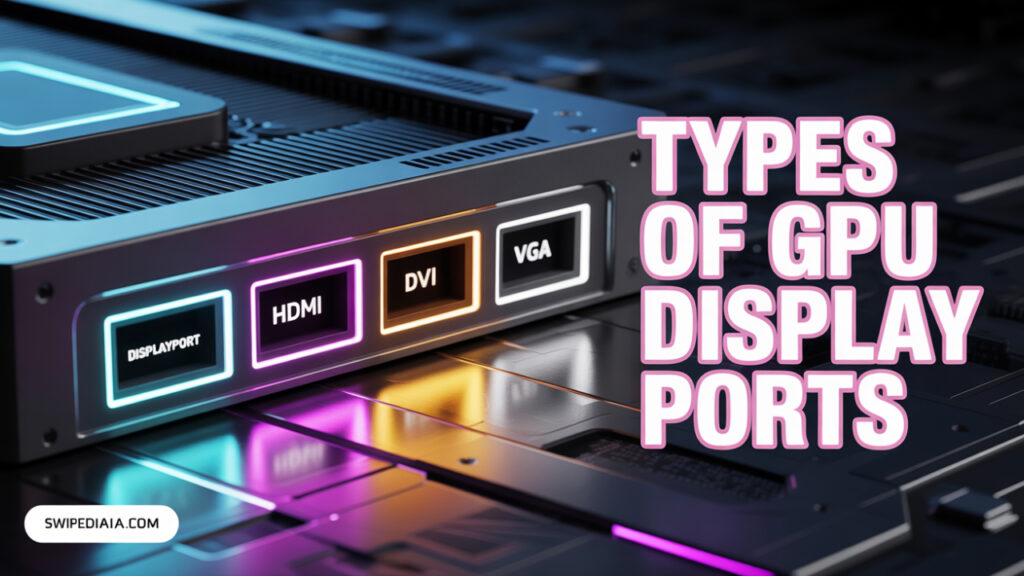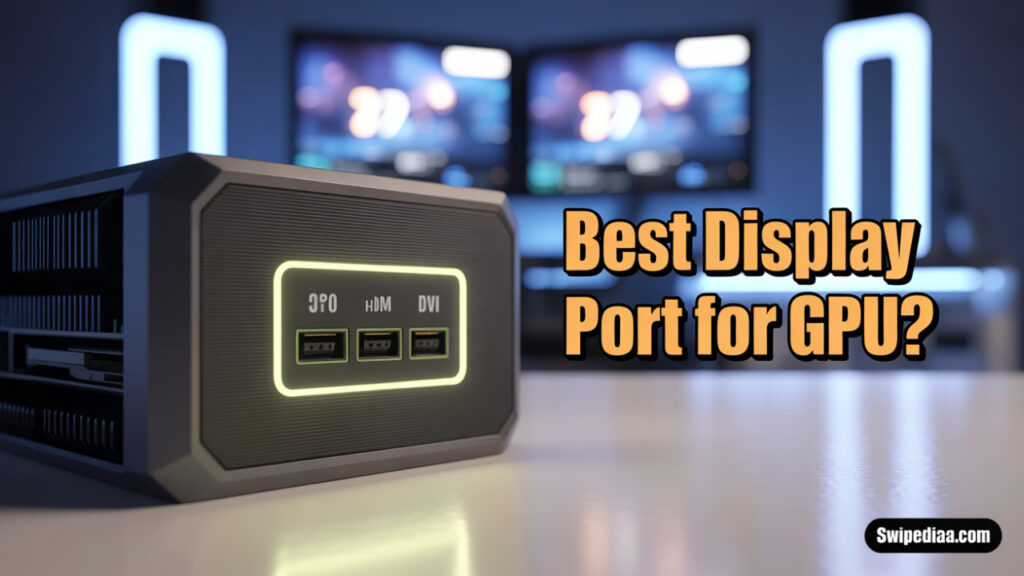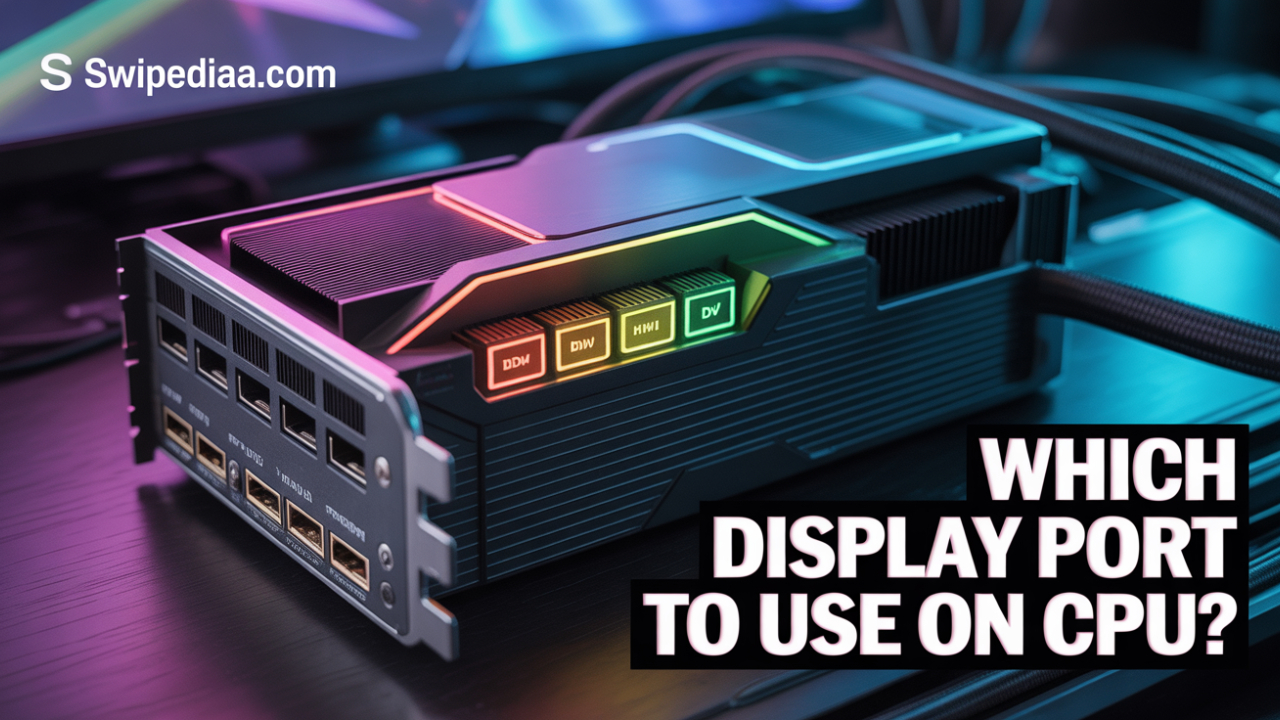Are you building a new PC or upgrading your graphics card and wondering which display port to use on GPU? You’re not alone. Choosing the right port is crucial for getting the best resolution, refresh rate, and overall gaming or productivity experience.
In this guide, we’ll cover everything you need to know — including different types of GPU display ports, their capabilities, and which one is best for your setup. Whether you’re a gamer, designer, or regular user, you’ll find this article super helpful.
Which Display Port to Use on GPU?
Display ports are the physical interfaces that allow your graphics card (GPU) to send video output to your monitor. Most modern GPUs come with several options, such as:
- HDMI
- DisplayPort
- DVI
- USB-C (VirtualLink)
- VGA (rare in modern GPUs)
Each of these ports supports different resolutions, refresh rates, and features. Choosing the wrong one can limit your GPU’s performance — especially if you’re gaming at 144Hz or running 4K monitors.
Types of GPU Display Ports (Explained)

1. HDMI (High-Definition Multimedia Interface)
Common on: TVs, monitors, GPUs, gaming consoles
Latest version: HDMI 2.1
- Resolution support: Up to 8K @ 60Hz or 4K @ 120Hz
- Best for: Gaming on TVs or monitors, streaming
- Audio support: Yes
Pros:
- Widely compatible
- Carries both audio and video
- Good for 4K gaming
Cons:
- Limited bandwidth compared to DisplayPort
- Older versions (HDMI 1.4) don’t support high refresh rates
2. DisplayPort (DP)
Common on: High-end monitors, GPUs, professional displays
Latest version: DisplayPort 2.1
- Resolution support: Up to 16K @ 60Hz or 4K @ 240Hz
- Best for: Gaming, professional editing, multiple monitor setups
- Audio support: Yes
Pros:
- Highest bandwidth (especially DP 2.1)
- Supports G-Sync and FreeSync
- Better for multi-monitor daisy chaining
Cons:
- Slightly less common than HDMI
- Some older monitors don’t support DisplayPort
3. DVI (Digital Visual Interface)
Common on: Older monitors, budget GPUs
Variants: DVI-D, DVI-I, DVI-A
- Resolution support: Up to 2560×1600 @ 60Hz
- Best for: Legacy setups or secondary displays
Pros:
- Still reliable for 1080p
- Compatible with adapters
Cons:
- No audio support
- Not ideal for modern high-res displays
4. USB-C (VirtualLink or Thunderbolt)
Common on: Newer GPUs, VR headsets, MacBooks
Resolution support: Depends on implementation (typically up to 4K @ 60Hz)
- Best for: VR setups, USB-C monitors, laptops
🔸 LSI/NLP Keywords: USB-C GPU port, VirtualLink GPU, USB-C display adapter
Pros:
- Single cable for power, data, and video
- Ideal for VR and ultrabooks
Cons:
- Limited GPU support
- Requires specific cable and monitor compatibility
5. VGA (Video Graphics Array)
Common on: Very old monitors and projectors
Resolution support: Up to 1080p (not digital)
- Best for: Emergency or legacy support only
Cons:
- Analogue signal = poor quality
- Not supported by most modern GPUs
Which Display Port Should You Use for Gaming?
If you’re a PC gamer, here’s what matters most:
| Use Case | Recommended Port | Why |
|---|---|---|
| 1080p @ 60Hz | HDMI or DVI | Both handle basic gaming well |
| 1440p @ 144Hz | DisplayPort | More bandwidth for high refresh rate |
| 4K @ 120Hz | HDMI 2.1 or DisplayPort 1.4+ | Required for ultra-high resolution |
| VR gaming | USB-C (VirtualLink) or DisplayPort | Faster transmission for VR headsets |
For optimal performance, use DisplayPort 1.4 or higher if your monitor and GPU support it.
Pro Tip: Check Monitor and GPU Compatibility
Before choosing a port:
- Check your monitor’s available ports
- Match with your GPU’s output ports
- Use DisplayPort where possible for modern setups
- Use HDMI 2.1 if you’re gaming on a TV
What if Your GPU and Monitor Ports Don’t Match?
Don’t worry — adapters and cables can help:
- DisplayPort to HDMI cable
- HDMI to DVI adapter
- USB-C to DisplayPort cable
Warning: Some adapters don’t support high refresh rates or audio — always check specs.
Future-Proofing Your Setup
If you’re buying a new GPU or monitor in 2025:
- Prioritize DisplayPort 2.1 or HDMI 2.1
- Avoid DVI and VGA unless necessary
- Choose monitors with G-Sync or FreeSync via DisplayPort for better gaming experience

FAQs – Which Display Port to Use on GPU?
Is HDMI or DisplayPort better for gaming?
DisplayPort is generally better suited for gaming due to its higher refresh rates and support for G-Sync and FreeSync.
Can I use an HDMI to DisplayPort adapter?
Yes, but ensure it’s an active adapter for proper signal conversion, especially if going from HDMI to DisplayPort.
Does DisplayPort carry audio?
Yes, just like HDMI. Ensure your monitor has built-in speakers or an audio output jack.
Why does my monitor show “No Signal” on DisplayPort?
Common reasons include a bad cable, unsupported resolution, or needing to change the monitor’s input manually.
Is DisplayPort backwards compatible?
Yes, DisplayPort is backwards compatible, but you’ll be limited by the lowest version supported by both the GPU and the monitor.
Final Thoughts: Which Display Port to Use on GPU?
Use DisplayPort if:
- You want the highest refresh rate, best resolution, or multi-monitor support
- Use HDMI if:
- You’re gaming on a TV or need widespread compatibility
- Use USB-C if:
- You have a USB-C monitor or VR headset
Always match your GPU’s port capabilities with your monitor’s input options for optimal performance.
